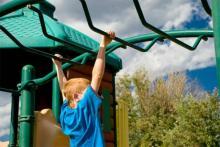
Brachiation is defined as locomotion accomplished by swinging by the arms from one hold to another.1 This term is also used to describe the skill developed by children on an overhead ladder.2
Overhead ladders and rings are found in many playgrounds. Many are free-standing, but in recent years the apparatuses have been linked to larger playground equipment utilizing decks to bridge from one activity to another. New designs including challenge ladders with unevenly spaced rungs, C- and S-shaped overhead ladders, and track rides have been developed to inspire play.3
Overall health, fitness, and physical development are some of the many benefits of brachiation. Skills developed from brachiation include building strength, endurance, and flexibility as well as eye-hand coordination, visual distance perception, and balanced locomotor patterns.4
Babies naturally grip with their hands and most children develop sufficient grip and upper body strength to support their body weight by the age of two unless they are overweight. Children also need to develop the skill of shifting their weight along with coordination and visual perception to accomplish using overhead equipment.5
Four skill levels describe the developmental progression for using an overhead ladder. Beginners are in the fundamental stage where they need full adult assistance to reach the first rung and to traverse to the next ones. In the practice stage, children have learned the fundamentals of traversing the overhead ladder and now can practice the skills attempting to do them without assistance. In the refining stage, children usually 4 to 6 years of age are able to swing more rhythmically showing more control. Children in the mastery stage, usually ages 6 to 9, move quite efficiently demonstrating an economy of motion.6
Brachiation ladders have been built and used for treatment of children with cerebral palsy, autism, and brain injuries as suggested by the teachings of Glenn Doman who has studied child brain development.7 He also suggests their use with children as young as two to expand their physical development which stimulates brain development and their learning capabilities.8
- 1. Dictionary.com, LLC. Copyright © 2010. < www.dictionary.com > 30 July 2010.
- 2. Frost, Joe L., Pei-San Brown, John A. Sutterby, Candra D. Thornton, The Developmental Benefits of Playgrounds. Olney, MD: Association for Childhood Education International, 2004. p. 89.
- 3. Ibid.
- 4. Frost, Joe L., Pei-San Brown, John A. Sutterby, James A. Therrell, Candra D. Thornton “Overhead Equipment Use: The Developmental Benefits and Use Patterns of Overhead Equipment on Playgrounds” Gametime.com. < http://www.gametime.com/_templates/dynamicTemplates/dynamicUploadedContent/files/research/frost-overhead%20equip-final.pdf > 30 July 2010
- 5. Op. cit., Frost, Brown, Sutterby, Thornton, p. 93.
- 6. Op. cit., Frost, Brown, Sutterby, Thornton, pp. 109-111.
- 7. “Doman Organization celebrates success in treating brain injured children” CP Discovery.com. < http://www.cpdiscovery.com/iahp-credited-for-brain-injured-girls-recovery.html > 30 July 2010.
- 8. “Baby’s Physical Development: crawling, creeping and brachiating” Child and Me. < http://www.childandme.com/babys-physical-development-crawling-creeping-and-brachiating/ > 30 July 2010.

